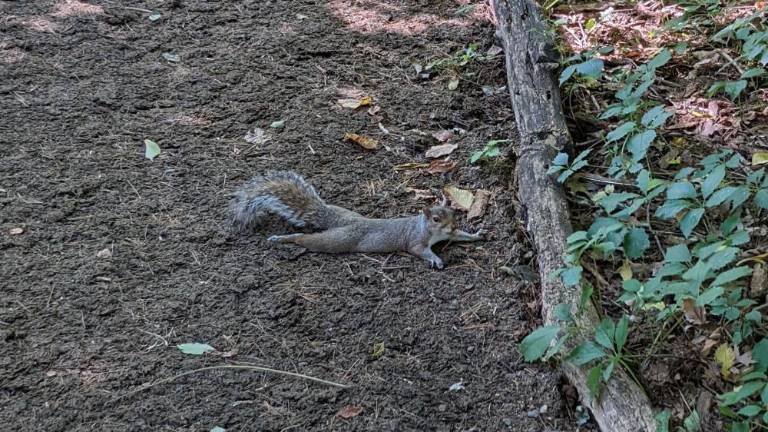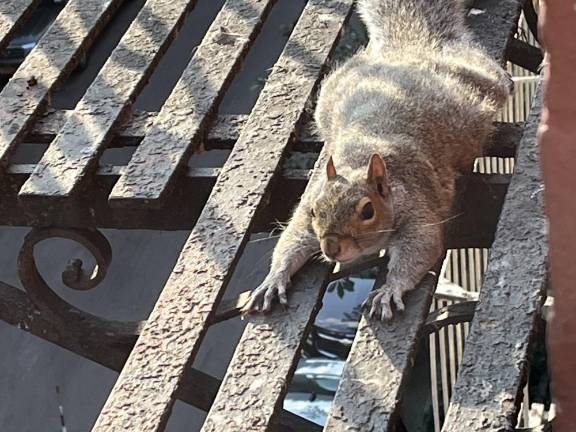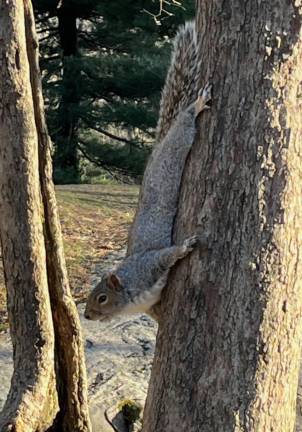City Squirrels Keep Cool by ‘Splooting’ in High Heat
NYC Parks tells New Yorkers not to panic about pancaking squirrels



New York City squirrels are beating the heat by utilizing a technique called “splooting.” The typically energetic animals have been seen around the city stretched out on cool surfaces with arms and legs splayed as temperatures have soared well into the 90’s. Many have been concerned by the upsurge of horizontal squirrels, but the New York City Department of Parks & Recreation assured New Yorkers in a viral tweet earlier this month, “If you see a squirrel lying down like this, don’t worry; it’s just fine.”
Humans respond to heat by sweating, dogs by panting, and squirrels have adopted the sploot. Squirrels’ underbellies have less fur than the rest of their body so by pressing their stomachs to cool surfaces like shady walkways or concrete, they can reduce their body heat. Many animals use the yoga-like pose to stay cool such as marmots, rabbits, cats, and dogs. In more scientific terms, splooting is known as “heat dumping.”
New York City has an especially active squirrel scene with numerous parks and a maze of neighborhoods for the curious creatures to explore. Projects like The Squirrel Census, enthusiastic squirrelers, and even squirrels’ biological response to a changing global climate have been an ongoing part of Manhattan’s urban ecosystem.
The Squirrel Census
While almost every park throughout the city hosts its own cohort of squirrels, the wooded oasis of Central Park is a popular hangout. Squirrels can also be seen throughout the city and will take advantage of rooftops, fire escapes, and even the smallest stands of trees. Most of New York City’s squirrels are eastern greys which come in a variety of colors such as cinnamon, ginger, dark gray, and black.
As a daily sighting for dogwalkers, runners, and parkgoers, many New Yorkers have wondered; exactly how many squirrels are in Central Park? The Squirrel Census, a multimedia science and storytelling project based in Atlanta, Georgia that focuses on the eastern gray, deployed 323 volunteer Squirrel Sighters in 2018 to find out. The census tallied 2,373 gray squirrels in their Central Park Squirrel Census 2019 Report, published in June of that year.
“It all started about eight years ago when a few squirrels started showing up in my neighborhood,” said Stuart Bowler, the Squirrel Census Chargé d’Affaires Northeastern Region. “They were on the fire escape and coming right next to my window which I had open all the time.” As Bowler’s passion for squirrels grew, he connected with a like-minded community of New York squirrelers, sharing posts of his resident squirrels on Instagram, and regularly visiting Central Park to visit the furry critters.
When Bowler heard the Squirrel Census was coming to New York, he had to get involved. He took part in the 2018 counting and has become a New York liaison for the Squirrel Census, knowledgeable about all things urban squirrel.
Through his many years on the squirrel scene, Bowler has seen a fair bit of splooting as squirrels have long used the technique, but this summer has garnered an exceptionally large number of sightings. “I see a splooting squirrel pretty much any time I go into the park,” said Bowler.
While the origin of the word “sploot” is hard to pin down, many have credited the term as emerging from affectionate names given to dogs over social media as well as being a variation of the words “splat” and “splay.” Bowler says the squirrel community often uses the term “pancaking” because it looks like they’re melting. “Exactly like a Dali painting,” said Bowler.
Handling the Heat
Squirrels’ response to high temperatures says a lot about how animals react to heat. It is also indicative of how they will adapt to rising temperatures as global warming is turning isolated summer heat waves into an increasingly common and severe occurrence. While this summer’s temperature spikes have left both humans and animals sweltering, there are likely to be hotter summers in the future.
“Squirrel populations are highly fluid, they really do change a lot,” said Bowler. For example, the coloring of their fur coats serves as a survival technique and depends on the environment they live in. Squirrels living in more densely forested areas in Central Park or street squirrels who live in alleyways will typically have darker coats so they can blend in with their surroundings.
“Droughts and the heat will without a doubt cause more deaths, but one adaption we might see more is loss of fur,” said Bowler. Squirrels molt in the warming months to keep cool and regrow their coats along with their ear tufts to keep warm in colder months. The coloring of their coats could also get lighter as temperatures continue to get hotter.
Caring for parks and shady spaces can do a lot to help urban squirrel populations survive the heat. Leaving out water on the fire escape for your neighborhood squirrels can also keep them cool, and if you’re feeling especially inspired in the August heat, take it from our nutty friends and start splooting!